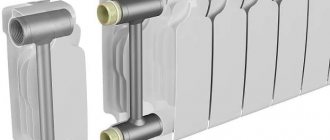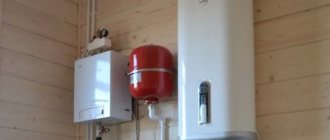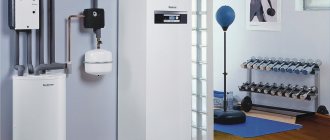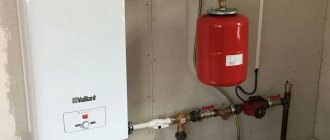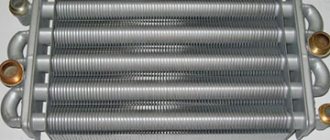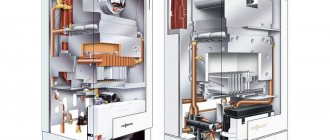Dimensions and weight
Dimensions are one of the most important differences between wall-mounted and floor-standing gas boilers. The dimensions and weight of wall-mounted models are much more modest, otherwise it would simply be impossible to mount them on the wall without the risk of collapse. The lightness of the design is achieved not only by the overall compactness of wall-mounted models, but also by the material from which the heat exchanger is made.
For wall-mounted models, the heat exchanger is made only of steel; floor-standing models may have heat exchangers made of cast iron, which is significantly heavier, or steel.
Wall-mounted boilers are often called mini-boiler rooms. And this is no coincidence, because a relatively small-sized housing houses not only the burner, heat exchanger and control system components, but a circulation pump, expansion tank and other elements without which the operation of a conventional boiler room is indispensable. The compactness of the wall-mounted boiler is its main and undeniable advantage. There is no need to allocate a separate room for such a device, because it can be placed anywhere, for example, in the kitchen.
Wall-mounted gas boiler with a coaxial chimney, located in the kitchen.
Floor-standing models inspire confidence with their size. This is exactly what a powerful boiler should be, providing the ability to heat a large building. However, the dimensions of floor-standing boilers often turn into a problem for their owners. Sometimes, in order to bring such a “giant” into a room, you have to dismantle the doorways. There were cases when, due to the impossibility of bringing equipment into the boiler room, the purchased floor-standing gas boiler had to be replaced with two smaller ones.
Floor-standing gas boiler and indirect heating boiler.
Advantages and disadvantages
Wall-mounted boilers do not require a separate room - they are installed anywhere in the apartment.
Each model has its own characteristics. The equipment is in high demand for a number of reasons:
- no need for a separate boiler room;
- compactness;
- autonomy;
- high efficiency;
- efficiency compared to devices running on other types of fuel;
- possibility of connecting to a gas cylinder and mains;
- easy operation.
There are also disadvantages:
- low power;
- dependence on electricity, sensitivity to power surges and the need to install an RCD for volatile models;
- installation permit is required.
The coolant for gas wall-mounted boilers must be of high quality.
Equipment
The factory configuration of a wall-mounted gas boiler, as a rule, includes not only the heating device itself, but also a circulation pump, an expansion tank, control system elements, and all the necessary sensors and valves. Moreover, all this is hidden in the body of the boiler itself.
By purchasing a wall-mounted gas boiler, you get a miniature boiler room for your use, that is, the minimum set that, after connecting to the heating system, is able to begin full-fledged work on heating your home.
Of course, if you wish, you can additionally purchase all kinds of room thermostats and regulators, outside temperature sensors, a GSM communication module and much more, improving the heating system of your home and increasing the comfort of its control.
A floor standing boiler is usually just a boiler. Circulation pumps, an expansion tank and many other related equipment are not included in the delivery package - you will have to purchase everything you need separately.
Wall-mounted gas boiler with lid removed.
Typical wall mount arrangement
There are a large number of manufacturers of gas boilers. Some have their own production base, while others order everything externally and simply stick their nameplate on the finished product. But what cannot be taken away from wall-mounted units is their sameness. They are all carbon copies. But at the same time they differ from each other in details
Wall-mounted boilers for heating a home are quite compact. Usually they do not exceed 45 cm in width. They are 70-80 cm in height. In fact, they can easily hang in your kitchen instead of some kind of shelf. The control panel is usually located on the front side. Sometimes it happens that all control is transferred to a separate remote control, which you place where it is convenient for you.
Inside, all wall mounts are equipped with the same thing, only in different implementations and designs:
- burner,
- heat exchanger,
- pump,
- hydrogroup,
- security groups,
- smoke exhauster (if the combustion chamber is closed),
- gas valve and other little things.
Easy to install
Which boiler, wall-mounted or floor-mounted, is easier to install? It would seem that this question should concern not potential owners of the unit, but exclusively the craftsmen who will be involved in deploying the heating system. However, do not forget that the buyer, that is, you, will have to pay for this, and the more labor-intensive the work, the more money you will have to part with.
In terms of ease of installation, the wall-mounted boiler is the undisputed leader. In the case of a floor-standing unit, you will have to equip an entire boiler room, because in addition to the boiler itself, you will have to install circulation pumps, an expansion tank and, perhaps, a boiler. The scope of work, as you might guess, differs very significantly, and the cost of the work will vary just as much.
Life time
When purchasing any equipment, especially expensive equipment, we want it to serve, if not always, then at least for as long as possible. This fully applies to gas boilers. Which boiler, wall-mounted or floor-mounted, will properly heat our home for many years?
The service life of a gas boiler is primarily determined by the service life of its heat exchanger. There is currently no consensus on which heat exchanger material is better - each has its own advantages and disadvantages.
In floor-standing models, cast iron heat exchangers are usually installed. Cast iron is less susceptible to corrosion, but at the same time it is fragile, which means there is a risk of microcracks forming during transportation. In addition, it does not tolerate sudden changes in temperature. When hard water is used as a coolant, the cast iron heat exchanger slowly deteriorates as a result of scale formation and, as a consequence, local overheating of the material.
Cast iron heat exchanger.
Cast iron heat exchangers are not suitable for wall-mounted gas boilers, because they are too heavy. The most preferred material in this case is steel. The latter is not afraid of shocks during transportation, but is highly corroded during operation, especially incorrectly.
Steel heat exchanger for a gas boiler.
So which heat exchanger is better? Since the boiler does not have to be transported very often, the factor that has the greatest impact on the service life of this structural element can be considered corrosion resistance. From this we can conclude that a longer period of normal operation can be expected from a floor-standing boiler with a cast iron heat exchanger.
We should not forget that the service life of the boiler is also affected by the wear of other structural elements - circulation pumps, gas valve, electronics, etc. The quality of the unit depends on the quality of each of its individual components. Practice shows that the average boiler from a well-known manufacturer who cares about the reputation of the brand will serve you well for 15-20 years, no matter whether it is wall-mounted or floor-mounted. No one knows what to expect from a “no name” unit.
Of course, in order for heating equipment to work long enough, you should follow all the manufacturer’s recommendations regarding operating conditions and carry out the necessary maintenance in a timely manner. The user can cope with many problems that arise on his own thanks to the self-diagnosis tools available in modern equipment.
Manufacturers with a solid reputation
Among the many manufacturers, users and experts identify several brands that can really be trusted.
German company Vaillant
Presents high-quality heating equipment in a wide variety of designs. These are single- and double-circuit equipment of condensation and convection type.
The power of the units varies from 4 to 280 kW. The advantages of Vaillant include high-tech equipment, which makes its operation extremely simple and comfortable. The manufacturer cares about the highest level of safety of its products.
The units are equipped with gas supply control systems, auto diagnostics and a variety of types of protection. The equipment has high efficiency. For condensation models it is about 109%, for convection models – 94%. Vaillant boilers can operate on different types of gas, are environmentally friendly and very economical. For the convenience of consumers, the company has deployed a wide service network.
Gas boilers from Vaillant are equipped with the most modern protection systems
The general disadvantages of the equipment include the lack of necessary voltage stabilizers in the equipment package and rather expensive service. In some cases, it may not be entirely fast. Users highly rate Vaillant brand equipment and consider it excellent.
Brand Buderus from Germany
Represents several lines of heating devices. Wall-mounted Logamax plus – condensing units with power from 14 to 100 kW, Logamax – convection units from 7.8 to 35 kW. Floor equipment is available in two lines. Logano plus – condensing units with power from 16 to 1200 kW, convection Logano units from 20 to 1200 kW. The range of equipment is very wide and includes all known modifications.
Boilers from Buderus are characterized by high energy efficiency, high-quality automatic control, making operation easier. They can be built into the remote control system and can be controlled remotely. The devices combine well with other branded equipment, are equipped with effective sound and heat insulation, are highly environmentally friendly and cost-effective, and have an attractive appearance.
Buderus gas boilers are easily integrated into the Smart Home intelligent system. They can also be controlled remotely using a mobile device
Equipment from Buderus is reliable, high quality, economical, versatile and unpretentious. They rarely fail. Among the disadvantages, it is worth noting the completely plastic make-up taps and the lack of protection against possible power surges.
Italian brand Baxi
Produces a wide range of heating equipment. A distinctive feature of this equipment is the presence of a total protection system against a variety of threats: freezing and overheating of the coolant, lack of pressure, etc.
The devices are equipped with manual and electronic adjustment and control systems, highly informative LCD displays, and built-in automation capable of responding to weather changes.
Baxi boilers are economical and equipped with modulating burners. They can operate in two temperature ranges. The units are easy to install and convenient to use. Among the significant shortcomings, it is worth noting some capriciousness of the electronics and the possibility of incorrect operation of temperature sensors.
Zhukovsky Machine-Building Plant
The largest domestic manufacturer of high-quality heating gas equipment. There are three main lines of production: “Comfort”, “Beetle” and “Universal”, within which more than 30 models of boilers for various purposes are produced. Their advantages include improved automation, which has led to an increase in efficiency up to 89% and a decrease in the toxicity of flue gases.
Wall mounted boilers from Baksi fit perfectly into any interior. They are economical and safe to use
The equipment is capable of working with two types of gas, has non-volatile ignition, is equipped with overheating protection and gas mixture pressure control. The boilers are inexpensive and there are no problems with spare parts for them. Disadvantages include slight noise during operation of the equipment and low quality of manual welding carried out at the factory. Whereas there are no complaints about automatic.
Important advice. Don't skimp on quality. It is better to pay a little extra and purchase a device from a brand with a good reputation. It will last much longer than a fake of unknown quality, attractive only for its low cost.
We also recommend reading our article on how to install a wall-mounted boiler yourself.
Coolant quality
The service life of a gas boiler and its output directly depend on the quality of the coolant. Using water with increased hardness as a coolant leads to the formation of scale inside the heat exchanger. Scale, in turn, causes a significant decrease in boiler efficiency and, as a consequence, an increase in fuel consumption.
The heat exchanger of the gas boiler is clogged with lime.
Both floor-standing and wall-mounted boilers “suffer” from scale to approximately the same extent; only the level of difficulty in solving an existing problem differs. The ease of disassembling and washing the steel heat exchanger of a wall-mounted boiler allows you to quickly restore the functionality of heating equipment right at the installation site.
Washing the cast-iron heat exchanger of a floor-standing boiler is difficult and, moreover, not always possible (many manufacturers insist that its disassembly and assembly be carried out exclusively in the factory). Most often, a faulty or clogged cast iron heat exchanger simply has to be replaced, and this part is by no means cheap.
It follows from this that installing a floor-standing boiler with a cast iron heat exchanger requires that you have a chemical water treatment plant. This device is not cheap, but in this case it is extremely necessary.
Conclusions and useful video on the topic
The expert from the video below will talk in detail about what myths exist regarding both types of equipment and what their features are during operation. This information should finally help you make your choice.
Each type of equipment has its own advantages and disadvantages, so it is impossible to single out a clear leader in this comparative review. It all depends on the conditions and at what facility the boiler will be operated.
Share what you were looking for when buying a gas boiler to furnish your own country house or city apartment. It is possible that your recommendations will be useful to site visitors. Please leave comments in the block below, post photos and ask questions.
Power modulation
Depending on the implemented method of regulating the flame intensity, all boilers are divided into boilers with a stepped or modulating burner. One- and two-stage burners have one or two operating modes, respectively (usually 100% and 70% of maximum). The power of modulating burners can be smoothly adjusted over a fairly wide range, which allows fine-tuning the operation of the boiler. Modulating burners provide fuel savings and allow you to maintain the set temperature with minimal deviations.
A significant part of floor-standing gas boilers are equipped with one- or two-stage burners. Most wall-mounted models have a wide range of power modulation (from 40 to 100%), due to which they operate “softer” - they turn on and off much less frequently than boilers with stepped burners.
Development and approval of the project
Installation work without a design permitting the installation of a heating boiler is prohibited. First of all, this is due to the high degree of danger of the work being carried out and the further operation of the equipment.
When drawing up design documentation, the features of the premises are taken into account. It must comply with all the requirements specified in the technical specifications. In addition, the project indicates a drawing for laying gas supply communications:
- in private houses - along the entire site up to the front door in a residential building;
- in apartments - from the front door to the point where the boiler is connected to the gas network.
When installing heating boilers, it is necessary to create a project, this is due to the high degree of danger of this structure.
The preparation of such documentation can only be carried out by authorized persons who have received a license for such work and are responsible for all calculations. The owners of the premises are prohibited from editing anything or making adjustments at their own discretion. Prepared project documents are subsequently sent for approval. This issue is dealt with by the gas supply technical department. Review may take from several days to several months, depending on the complexity of the drawings and the characteristics of the premises.
Along with the project for which boiler equipment will be installed, the following must be submitted for approval:
- technical passport of the unit;
- installation and operating instructions;
- certificates confirming the boiler’s compliance with sanitary and technical standards;
- confirmation of an examination of the boiler, revealing its compliance with safety standards.
When choosing heating equipment, you need to know what gas boilers are and their characteristics
The buyer receives all these documents when purchasing equipment
If it was not possible to achieve a positive decision on the installation, you need to pay attention to the reason for the refusal. Specialists reviewing the project are required to list the actions, the implementation of which will subsequently allow obtaining permission
Once the documents are approved, you can proceed to installation work.
Energy independence
For some consumers, an important parameter of a gas boiler may be the dependence of its operation on electricity. The energy independence of heating equipment is relevant for those whose house or cottage is located at a considerable distance from large populated areas, i.e. in places where power outages or power surges in the network are possible, leading to the failure of expensive automation.
Autonomy of a gas boiler can be achieved in two ways. The first is to simplify the boiler control system as much as possible. That is, it is necessary to use a unit in which there is no electronics at all. All automation of such a boiler is mechanical. A heating system that uses a similar boiler that operates without electricity must have natural circulation.
The second method is to use an electric generator, which converts the heat obtained by burning gas into electricity necessary for the operation of the boiler automation. This option is preferable for most users because it creates fewer restrictions.
You can find energy-independent models only among floor-standing gas boilers, which for some buyers will be a strong argument in favor of the latter.
How to choose the right boiler
How to choose a boiler
Choosing the right boiler is easy if you understand the technical features of each model. To do this you need to answer the following questions:
- What power should the boiler be?
- What level of comfort do you want to achieve in the end?
- What kind of gas consumption savings are you planning?
- Which manufacturer do you trust?
Boiler power
It is the boiler power that is the main parameter of its operation. It is indicated both in the technical data sheet of the device and on the packaging itself. Your task is to correctly calculate it first. How to do it?
The main ratio of the parameters is as follows: for 10 units of area you need to allocate 1 kilowatt of device power. For example, to heat a compact country house with an area of 250 square meters, you will need a boiler with a capacity of 25 kilowatts.
Comfort when using the equipment
The level of comfort when using the equipment, as well as the conditions it helps to create, will depend on the way the heat is controlled. There are models on sale that have one-stage adjustment. This means that the device will operate at the same power level. The range of different manufacturers includes both two-stage (work is carried out on two levels) and three-stage boilers (the ability to continuously regulate power).
What to give preference to? Experts recommend choosing the second option. At the first power level, the burner will operate equally at both sub-zero and positive temperatures, which is not economical. With two-stage adjustment, it becomes possible to independently select operating modes and extend the life of the device. The third option is also convenient, but models equipped with three-stage adjustment are much more expensive.
With or without automatic
Boiler automation
Many modern models have an electronic control unit that helps monitor the operation of the unit and set optimal modes. Almost all imported gas boilers operate with electric feed. Western manufacturers are not familiar with the problems of intermittent power supply, but you and I are well aware of them.
What to do if power outages occur very often? The problem can be solved in two ways:
- Firstly, it is easy to refuse automation by purchasing the simplest models, which always maintain only the temperature set by the manufacturer. In this case, the room temperature is not taken into account at all.
- Secondly, purchase a generator that itself generates electricity from the heat produced by the boiler. If you have money, this is the best option.
Chimney device
Connection diagrams for solid fuel boilers
When choosing a gas boiler, you also need to pay attention to the design of its chimney. There are models on sale that provide for the forced elimination of combustion products. There is no need to construct special ventilation ducts for them; it is enough to make one hole in the wall of the house and lead the pipe directly into it.
Such boilers do not burn oxygen during operation, and they do not require the construction of an inflow to help the burner function normally. All combustion products are discharged through the pipe using a specially built-in fan. Such models are an order of magnitude more expensive than analogs that are simpler in design, but these costs are offset by ease of installation.
Installation site requirements
Before choosing a floor-standing or wall-mounted gas boiler, you should resolve the issue regarding its installation location.
Due to its compactness, the wall-mounted boiler can be placed in almost any room. The main thing is that a number of requirements are met to guarantee the safety of its operation: a closed combustion chamber, connection to a coaxial chimney, forced removal of flue gases and injection of air to maintain the combustion process. Installing a boiler with an open combustion chamber in a kitchen where there is a hood is unacceptable, since in this case a so-called “draft reversal” is possible, in which the smoke from the boiler will not go into the chimney, but into the room.
There are not many options for placing a floor-standing gas boiler. Due to the size of the boiler itself, as well as all kinds of related equipment, we can only talk about a separate room - the boiler room. Despite the fact that the boiler room does not belong to residential premises, when installing a gas boiler, it is necessary to ensure normal removal of fuel combustion products and air flow.
Types of heating devices
The store variety is a little scary and disorienting. It is difficult to immediately decide on the right model. To make this easier, let’s get acquainted with the main features of devices that determine their performance characteristics.
Gas burner type
Two types of burners can be installed in attachments. The simplest one is the so-called atmospheric one. The principle of its operation is very simple: gas fuel burns inside the unit. This requires air that enters the device from the room where the boiler is located. To ensure a continuous flow of air masses and at the same time get rid of toxic flue gases, it is necessary to install a chimney.
In this case, only a traditional vertical high chimney, correctly designed and correctly installed, can be used. The draft is provided by the temperature difference between the room and the street. As a rule, with proper calculation, it is quite sufficient for normal operation of the boiler. An atmospheric burner has significant advantages.
A boiler with a closed burner is more efficient and economical, but equipment with an atmospheric burner can operate in conditions of lack of electricity
First of all, it does not require electricity to use. The boiler can be operated in the complete absence of power supply, which is very important for places where electricity is not always available. In addition, the cost of boilers equipped with such a burner is significantly lower than their analogues. However, you need to understand that for the safe use of such equipment, you will need to install effective ventilation in the room where it is installed.
It is advisable that such devices be installed in a separate room. A prerequisite for operating the device is the presence of a smoke exhaust. And another minus is the relatively low efficiency.
The presence of a closed burner implies that air is forced into it. For this purpose, an additional system equipped with a pump is installed. It takes outside air and supplies it to the combustion chamber and at the same time removes flue gases.
Such equipment is equipped with a coaxial type chimney. These are compact structures consisting of pipes nested inside each other. Smoke is removed through the inner part, and air is drawn in through the outer part.
This chimney is very effective, takes up little space and is quite easy to install. It can be installed not only vertically, but also horizontally at a slight angle. In the latter case, the passage to the street is made directly in the wall.
A boiler with a closed burner has a higher efficiency, which allows its owner to save fuel
The advantages of closed burners include high efficiency and complete safety during operation. They do not take air from the room, so they can be installed in bathrooms or kitchens. However, they require electricity to operate, otherwise the boiler will simply stop. The cost of devices with closed burners is much higher than that of equipment with atmospheric ones.
Number of device circuits
Mounted boilers can have one or two heating circuits. In the first option, the equipment is equipped with one heat exchanger, which is used only to heat the coolant fluid. Thus, the device is intended exclusively for heating. If hot water supply is also required, additional equipment is installed, which will certainly take up some free space.
The main advantage of single-circuit models is their simplicity of design, which simplifies their installation and operation, as well as greater power compared to double-circuit analogues. The latter have two built-in thermal circuits. In one the coolant is heated, in the second - water for hot water supply. This makes their design more complex and vulnerable. Boilers with a so-called bithermic heat exchanger are produced.
A single-circuit mounted boiler provides only heating of the coolant. The number of radiators it serves is determined by the power of the device
It is divided into two segments, one for coolant, the second for hot water. Thus, a dual-circuit device works with only one heat exchanger. As practice shows, bithermal devices are not reliable enough and are not very convenient to use.
If necessary, it is optimal to purchase a unit with two separate heat exchangers. Double-circuit boilers spend their power not only on heating, but also on hot water supply, so it is somewhat lower.
Such devices are ideal for small apartments or houses. You need to understand that double-circuit equipment is most often not capable of providing a large amount of hot water. If your DHW needs exceed 15 liters per minute, it is worth purchasing a single-circuit model and additional heating equipment.
You should do the same if you have too hard water. In this case, the secondary heat exchanger will very quickly become covered with deposits and fail.
Use of condensate heat
Condensing units appeared on the domestic market not very long ago, while they are used very widely throughout the world. Their distinctive feature is the ability to use heat from water vapor generated during the combustion of a gas mixture. The latter is collected in the form of condensate in an additional heat exchanger. Here it gives off its heat to the coolant liquid.
A condensing type gas boiler has an efficiency of more than 100% due to the use of heat obtained from exhaust flue gases
In this way, it is possible to obtain additional thermal energy, which makes the use of a condensing boiler as efficient as possible. According to experts, the efficiency of such devices is above 100%, which may seem fantastic. However, this is reality. The device gains an additional 9-11% efficiency by using the heat of the exhaust flue gases. The average efficiency of such boilers reaches 105-111%.
The advantages of condensing equipment include economical fuel consumption. Compared to traditional convection appliances, it is about a third smaller. The gases discharged from the boiler have a low temperature, which makes it possible to install cheaper and easier-to-install plastic chimneys. The amount of toxic emissions from a condensing boiler is minimal, and the noise level during operation is also low.
The disadvantages of such equipment include a small temperature difference between return and supply. For traditional convection devices it averages 55° to 75°, for condensing devices it is 35° to 55°. Thus, to warm the room, you will need to install additional radiators or install a heated floor system. In addition, the condensate formed in the boiler must be disposed of.
Externally, condensing boilers do not differ from their convection counterparts. They are only slightly larger due to the fact that an additional heat exchanger is installed in the housing
This is quite problematic because it contains acid. It is unacceptable for it to end up, for example, in a septic tank. It is advisable to install a special system to collect condensate. However, for low-power boilers located in houses with centralized sewerage, this is not necessary.
Another significant disadvantage of condensing equipment is its high cost. Compared to traditional analogues, it is 20-35% higher.
Power
The power of wall-mounted gas boilers, as a rule, varies from 10 to 40 kW. This, according to a rough estimate, is enough to heat a home with an area of 100 to 400 square meters. m. However, if part of the heat is used to heat water for domestic needs, then this power will be enough to heat only a relatively small house.
The capabilities of floor-standing gas boilers are significantly higher. The power of floor-standing models can reach 80-100 kW, and if it is equipped with a forced-air burner rather than an atmospheric one, then even more. If you need to heat a huge house or industrial facility, then a floor-standing boiler is exactly what you need.
Which boiler is best for a home or apartment?
It is difficult to give a universal assessment, since each situation is individual, but basically in practice it happens like this:
- floor structures are purchased for heating the private sector (houses, cottages);
- hanging - for apartments due to their small size and visual appeal.
Although it is important to make a reservation here. In every sense, floor-mounted mini-boiler rooms are definitely more reliable, since they have a more durable heat exchanger, and they are also easy to use even at critically low temperatures outside.
Plus, add energy independence to everything, and then you will understand why many people prefer to install them even in apartments.
Wall-mounted boilers are good because they can be built into kitchen units and take up a minimum of usable space in small urban kitchens
But if you have limited living space and live in a region where severe frosts are very rare, it is more rational to install a wall modification. It will also cost less.
Final comparison of wall-mounted and floor-standing gas boilers
| Wall-mounted gas boiler | Floor standing gas boiler | |||||||
| Dimensions | Less | More | ||||||
| Weight | Less | More | ||||||
| Equipment | The boiler is equipped with additional equipment | Additional equipment must be purchased separately | ||||||
| Easy to install | Easier | More difficult | ||||||
| Life time | Steel heat exchangers are more susceptible to corrosion, which reduces service life | Units with a cast iron heat exchanger can operate for a longer time | ||||||
| Coolant quality | The dependence on the quality of the coolant is high, but it is easier to flush the heat exchanger | The dependence on the quality of the coolant is average, but it is more difficult to flush the heat exchanger | ||||||
| Power modulation | More possibilities | Fewer features | ||||||
| Energy independence | Fully volatile units | There are non-volatile units | ||||||
| Installation site requirements | Less | More | ||||||
| power, kWt | 10 — 40 | 80 — 100 | ||||||
| Price | Below | Higher | ||||||
If you notice an error, a non-working video or link, please select a piece of text and press Ctrl+Enter .
0

